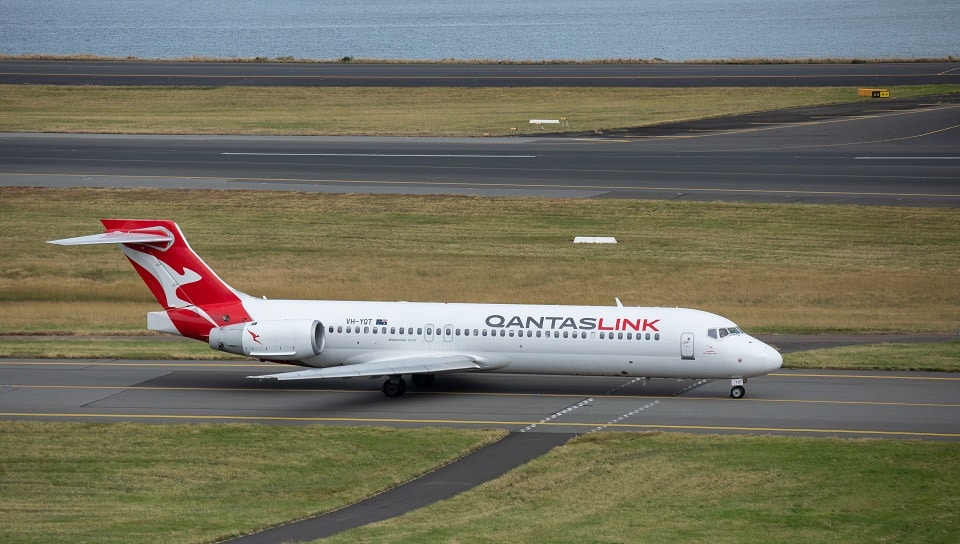Airlines
End of an Era: Qantas Farewells Boeing 717 And Welcomes New Aircraft

A Boeing 717 airplane operated by Qantas, the first of its kind to be registered and operated in Australia, will depart, signaling the end of an era. The departing 717 (registration VH-NXI) holds a special place in the Qantas Group’s modern history, having operated Jetstar’s first flight between Melbourne and Launceston on the day the airline started flying in May 2004.
The aircraft has also flown on regional and domestic routes for QantasLink for the past 15 years. All up, it has completed more than 29,000 flights and safely carried more than 1.6 million customers for both Qantas and Jetstar over two decades.
All of QantasLink’s 20 Boeing 717s will be gradually replaced by 29 fuel-efficient Airbus A220 aircraft as part of the “Project Winton” fleet renewal program. The first A220 aircraft is due to arrive later this year and the first of 20 A321XLRs will arrive in late 2024.
QANTAS FAREWELLS “QUEEN OF THE SKIES”(Opens in a new browser tab)
The departing 717 was flanked at Sydney Airport today by two new arrivals in the fleet – a Boeing 787 Dreamliner and a Jetstar A321neo LR. The next-generation aircraft are part of a significant investment in the fleet renewal that will see the Group take delivery of a new aircraft every three weeks on average for the next few years. The incoming aircraft will help Qantas and Jetstar restore capacity and expand their network while lowering emissions and improving efficiency.
Qantas’ latest Boeing 787 Dreamliner, Billabong, started flying on the airline’s international network this month, with another two Dreamliners to be delivered over the next three weeks. These additional aircraft enabled the resumption of Sydney-San Francisco flights and will support the launch of the Sydney to New York via Auckland route next month. This will bring Qantas’ 787-9 fleet to 14.
Jetstar Unwraps Its New A321LR Before Christmas(Opens in a new browser tab)
Jetstar also this month welcomed its seventh Airbus A321neo LR aircraft, which is 50 percent quieter than the older A321s they replace and burn up to 20 percent less fuel. They are operating domestic services and flying between Australia and Bali. The airline will receive another 11 A321neo LR aircraft by the end of 2024.
Through a combination of new arrivals and standby aircraft returning to service, the Qantas Group has returned to around 100 percent of pre-COVID domestic flying levels and expects to restore 100 percent of international flying by March 2024.

Airlines
Air India Rolls Out A350s for Delhi-New York JFK and Newark Routes

In a major development for North American travelers, Air India has announced the deployment of its state-of-the-art Airbus A350-900 aircraft on two key routes: Delhi to New York and Delhi to Newark.
The service on the Delhi-New York route will commence on November 1, 2024, while the Delhi-Newark route will see its inaugural flight on January 2, 2025.
The introduction of the air india a350 will bring significant enhancements to Air India’s offerings, particularly with the launch of its Premium Economy class. air india retrofit This new class will feature 24 wide seats arranged in a 2-4-2 configuration, providing passengers with extra legroom and a more comfortable flying experience.
Soon, Air India aircraft will feature onboard WiFi & all-new cabins: Click here
“We are encouraged by the positive guest feedback we have received from the domestic deployment of our air india a350 interior to offer our hero product on the Delhi-New York JFK and Delhi-Newark routes. This is a significant leap forward for our U.S. operations that also underscores our commitment to continuous improvement,” said Campbell Wilson, Chief Executive Officer & Managing Director of Air India.
The A350’s Business class will set new standards with 28 private suites, each equipped with full-flat beds, direct aisle access, and personal wardrobes. Economy class will be configured to accommodate 264 passengers in a 3-4-3 layout. Across all cabins, passengers will enjoy the latest Panasonic eX3 in-flight entertainment system, offering over 2,200 hours of content.
Air India’s First A350-900: Interior, Routes, &Inflight Features: Click here
This strategic deployment marks a notable enhancement in Air India’s U.S. operations, with 60% of its flights to the U.S. now featuring new or upgraded cabin interiors. The air india new international routes currently operates 51 weekly flights to five U.S. destinations: New York JFK, Newark, Washington DC, Chicago, and San Francisco.
The revamped cabins, advanced in-flight entertainment systems, and improved service standards represent air india wifi commitment to providing a superior travel experience. “We believe this enhanced offering will solidify Air India’s position as a leading carrier and attract travellers seeking a world-class flying experience between India and the United States,” the airline stated.
Seats on these flights are now available for booking on Air India’s website, mobile app, and through travel agents, ensuring that passengers can easily plan their journeys on these newly upgraded routes.
Air India Economy vs Qatar airways economy: which is best?:Click here
-

 Travel1 week ago
Travel1 week agoAir India to Expand US Operations with Three New Routes After a Decade
-

 Travel2 weeks ago
Travel2 weeks agoWhy We Should Avoid These Stamps in a Passport
-

 Airlines1 month ago
Airlines1 month agoInvestigations Reveal Fake Chinese Titanium in Boeing and Airbus Jets
-

 Tech4 weeks ago
Tech4 weeks agoChina’s CATL Plans 1,800-Mile Electric Plane Launch by 2027
-

 Airport3 days ago
Airport3 days agoTop 10 Largest Airports in the World by Size
-

 Aerospace4 weeks ago
Aerospace4 weeks agoChina’s Fighter Jets Turn Wings into Autonomous Drones
-

 Airlines4 days ago
Airlines4 days agoAir India Rolls Out A350s for Delhi-New York JFK and Newark Routes
-

 Defence3 weeks ago
Defence3 weeks agoBoeing Enhances Chinook with New Engines and Block II Upgrades at $96 Million







